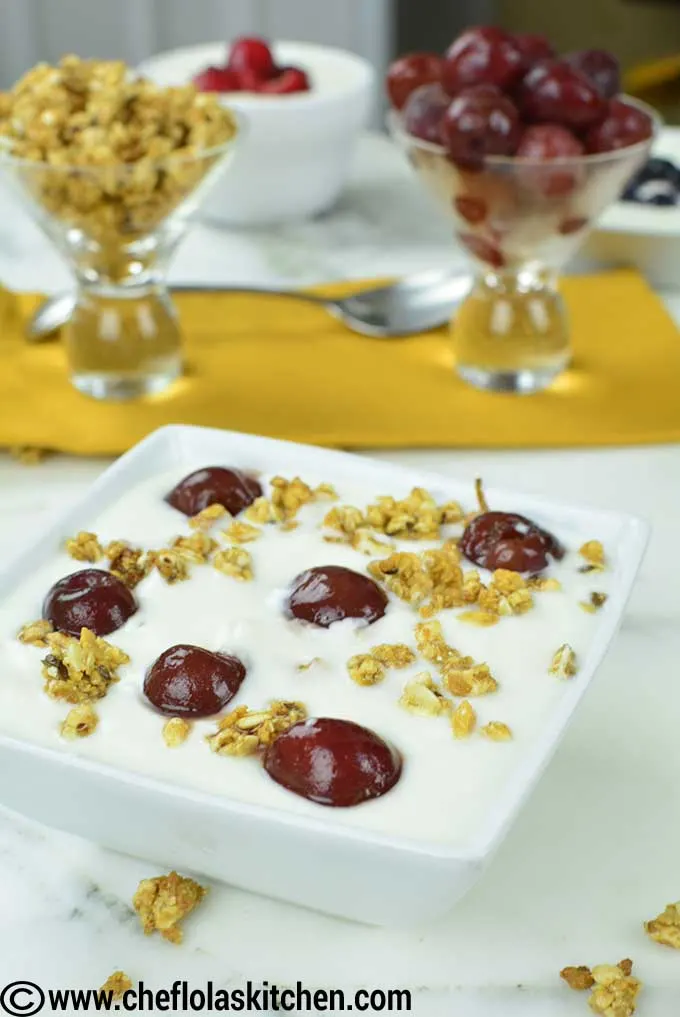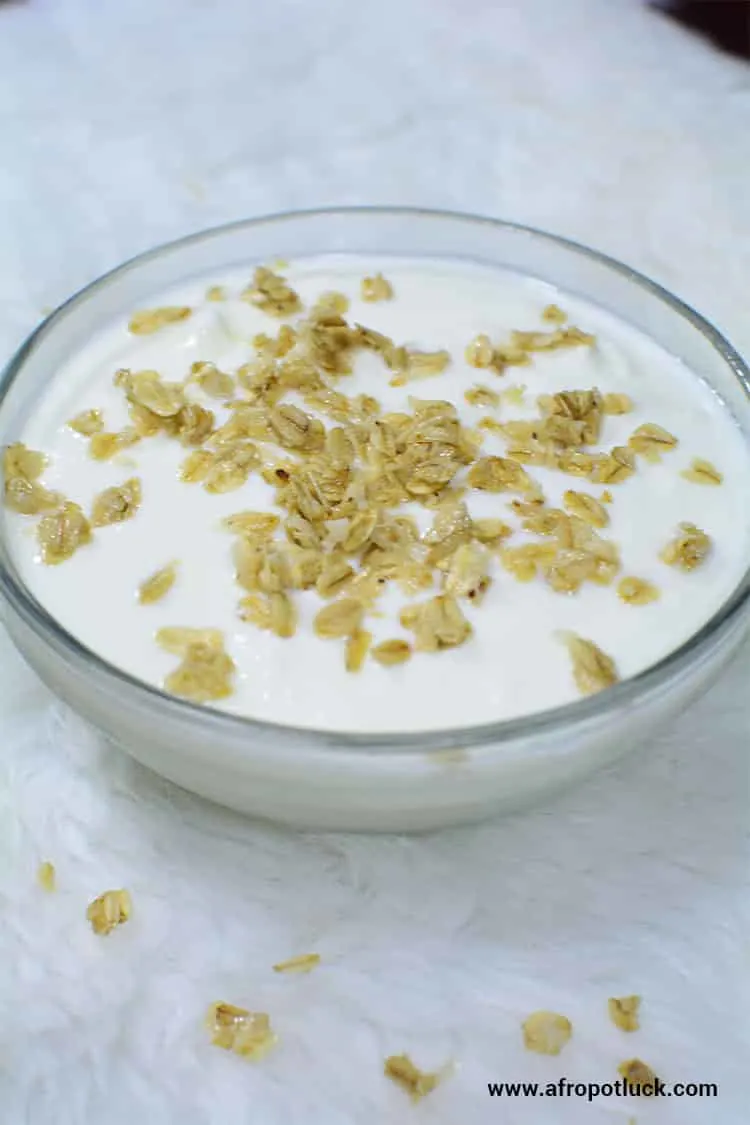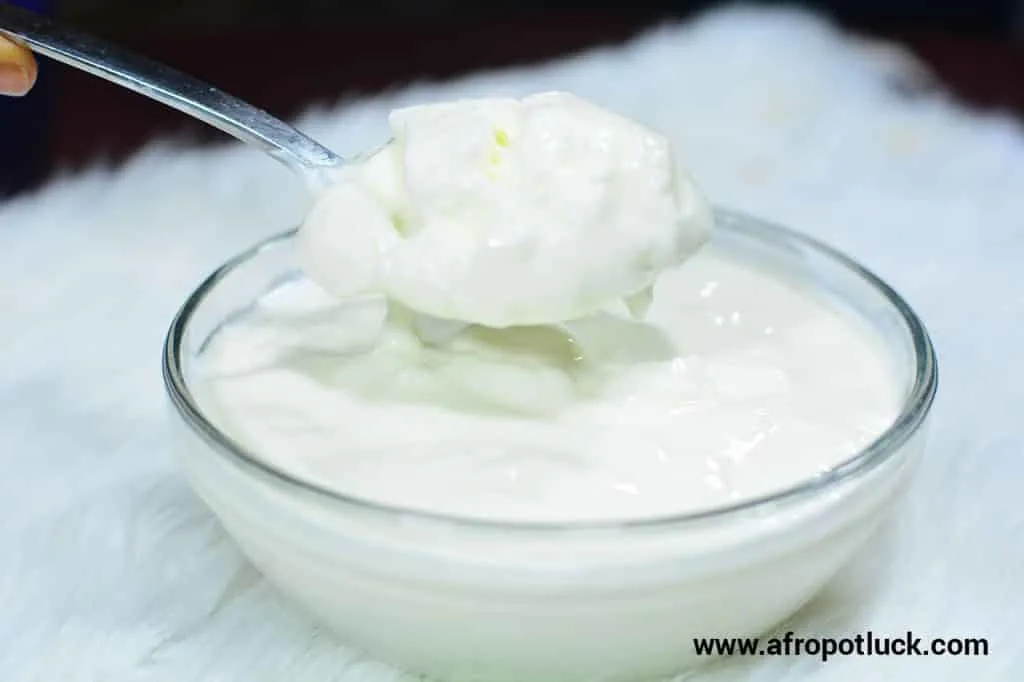


How to make the thick Greek yogurt.
Fold a cheesecloth 4-6 layers and hang it for a few hours so that the water in the Yogurt can drip from it and you will be left with a rich, thick and creamy Yogurt.
I used the “pinky test” (no thermometer) and incubated in my Oven with the light on to create a warm environment for the Yogurt bacteria to grow.
A Thermos will also do this perfectly. It’s extremely easy and economical, and resulted in a very mild yogurt that doesn’t require much sweetening, and has lots of versatility.
A dutch oven or a heavy disc bottom pot will be a great help to reduce scorching of the Milk so it’s a good idea to invest in one.
Do you need further help in making your homemade yogurt? Read below to get the answers to the FAQS about Yogurt.

FREQUENTLY ASKED QUESTIONS ON MAKING HOMEMADE YOGURT
WHY DO YOU NEED TO BOIL THE MILK BEFORE MAKING YOGURT?
The biggest reason to heat milk to almost boiling before fermenting is that it improves the texture of the yogurt.
During fermentation, the bacteria consume lactose and produce lactic acid which causes the milk proteins to denature and coagulate trapping most of the fat. The proteins involved are primarily the casein proteins.
When this happens, there is still quite a bit of protein left that isn’t bound up in the new casein mesh. All of the albumin proteins are water soluble and will not add to the structure of the yogurt.
These albumin proteins denature when you heat them. For this reason, recipes universally call for us to heat the milk to 190 and then cool. The albumin is denatured and is able to tangle up with the casein during fermentation and add to the yogurt structure.
Skipping this step will make a very profound difference to the structure of your yogurt. Without it, your yogurt will be thinner and much more fragile. When you scoop it there will be more whey and all that albumin will wash out in it
IS MAKING YOUR OWN HOMEMADE YOGURT COST EFFECTIVE?
Making your own homemade yogurt will save you very when it comes to monetary value, but it’s good to make it at home at least once in a while not just because it tastes so much better but it provides more active cultures which are highly beneficial to the health.
Most of the commercial yogurts aren’t incubated/cultured properly and then need fillers to make them thick.

HOW DO YOU GET A THICK AND CREAMY HOMEMADE YOGURT?
Keeping a consistent temperature and leaving the Yogurt undisturbed between 105-110º will yield a thick, creamy and sweet Yogurt. If possible, leave it overnight and if you still want it thicker, simply strain it with a cheesecloth. Please refer to my explanation on how to make thick Greek yogurt above.
WHAT IS YOGURT STARTER?
According to culturesofhealth dot com, a yogurt starter is a carefully balanced blend of bacteria which consume lactose. This blend of bacteria converts the lactose in milk to lactic acid, giving yogurt that classic, deliciously tangy taste.
The starter contains live bacteria culture that converts the Milk into Yoghurt
Notes:
I don't make use of thermometers for my homemade Yogurt, however, I will suggest you get one if you are worried about temperature measurement
Use whole Milk. This Milk produced the richest and thickest Yogurt
I only used 2 tablespoons of Yogurt from a store-bought yogurt, I did not use any packaged starter for this recipe.
I sprinkled my homemade Granola on my yogurt but you can use fruits or any other flavorings of your choice.

How To Make Yogurt (VIDEO)
Instructions
- Pour the Milk inside the Pot and heat it up to about
- Remove it from heat and allow it to cool down till it’s warm to the touch ( 110°F to 115°F. )
- Stir in the starter culture. Make sure to completely dissolve in the Milk.
- Cover it up with a tight-fitting lid and keep in in the Oven with the light on for 6 to 12 hours depending on how tangy you want it to be.
- Chill in the fridge for about 2 hours or more before serving.
- You can add sweeteners of your choice, fruits, or simply customize it to your taste.

Christie
Sunday 30th of January 2022
My first trial ans came out very smooth and creamy. I tasted it until I finished it and forgot to leave some for my starter...
I can now produce nice tasty and creamy yogourt.
Thanks Lola.
innocent
Wednesday 6th of October 2021
very straight forward
Nicki Martins
Tuesday 8th of June 2021
Good day ma.Hope you are good? Please am finding it difficult to make a plain sweet yoghurt and parfait.Please help me with a recipe.
I have also tried most of your food recipes like eforiro, spaghetti,rice,sauce and soup recipes.Thanks for all you do.
Chef Lola's Kitchen
Tuesday 8th of March 2022
So happy to hear that you have tried out the recipes and they all came out well. You can check for yoghurt reipe on the blog.
Tolulope
Thursday 4th of March 2021
Welldone Chef Lola, my oven doesnt have any light how else do i generate heat in the oven pls?
Lola Osinkolu
Wednesday 14th of July 2021
Look for a very warm spot around the house.
Ayodele Abosede Oluyemisi
Thursday 4th of February 2021
Very interesting